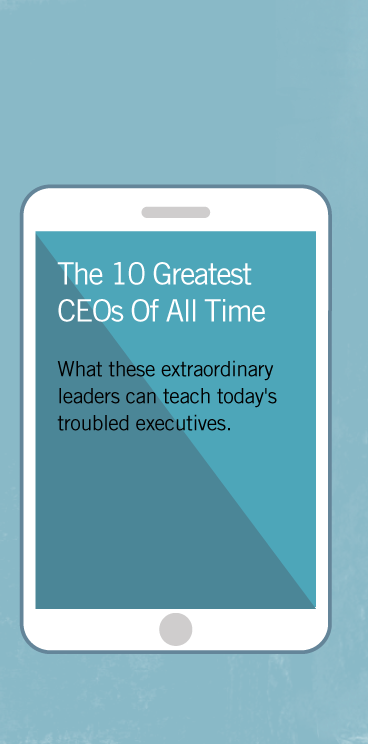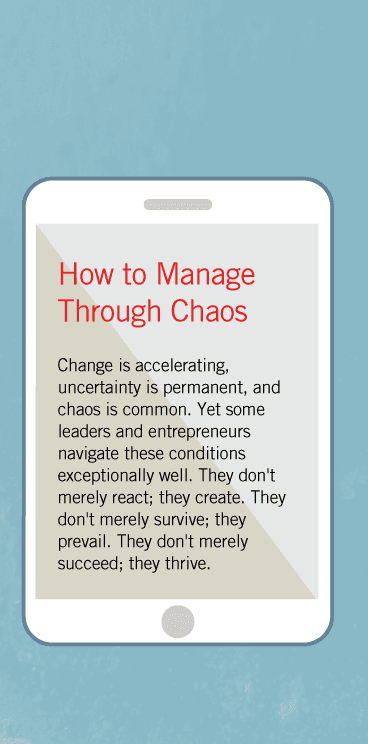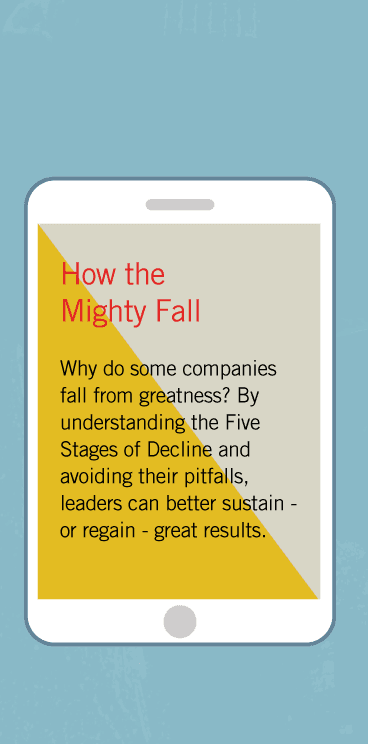Sometimes a Great Notion
But not always. A surprising number of companies we consider great today did not start out with a compelling idea for a product or service.
I don't know how many times I've heard people say, "I'd love to start a company, but I don't have a great idea." My response: Neither did the founders of Sony, Hewlett-Packard, Marriott, Motorola, Honda, Disney, Wal-Mart, Nordstrom, Merck, or Procter & Gamble. But that didn't stop them from getting started. If they'd waited until they had the great idea, I suspect those companies would not exist today. If you are waiting for the lightning bolt of a great idea—or even a good idea—before truly committing yourself to building your company, you may be waiting for a long time.
Believe me, I didn't always think that way. But I began to question the common wisdom when I came across a story a few years ago. It went like this:
In 1945 a young inventor named Masaru Ibuka decided to start a company among the ruins of a defeated Japan. He rented a room in a bombed-out department store in Tokyo and, with seven employees and $1,600 of personal savings, started to work. But what to work on? Ibuka had a company but no idea. According to Akio Morita, who joined the company shortly thereafter, "the small group sat in conference in the depressing surroundings of the burned-out department store, and for weeks they tried to figure out what kind of business the new company could enter." Ibuka's company is known to all of us today as Sony Corp.
Hewlett-Packard started much the same way. When Bill Hewlett and Dave Packard founded their company in the late 1930s, they had no specific idea to pursue. Their primary goal was to go into business together in the vaguely defined electronic-engineering field. Here is how Bill Hewlett described the early days (courtesy of HP company archives): "We didn't have any plans when we started—we were just opportunistic. We did anything that would bring in a nickel. We had a bowling foul-line indicator, a clock drive for a telescope, a thing to make a urinal flush automatically, and a shock machine to make people lose weight. Here we were, with about $500 in capital, trying whatever someone thought we might be able to do."
Fascinated, I decided to take a closer look at the beginnings of a number of today's outstanding companies. I discovered that many of the founders had committed themselves to creating a company and then figured out what products to make or services to offer. Even in cases in which the founders started out with an idea, it seldom was a great idea and often turned out to be a bad one.
Paul Galvin started out repairing and later manufacturing battery eliminators for Sears radios. Galvin was driven by the ambition to work for himself and to build his start-up—a five-person enterprise—into a great and lasting company. From those humble beginnings, we now have Motorola Inc. J. Willard Marriott wanted to create a successful enterprise that he could build into an institution. The young Mormon missionary started his company, now Marriott Corp., with an A&W Root Beer stand in Washington D.C.
In 1946 Soichiro Honda created the Honda Technical Research Institute, later known as the Honda Motor Co. But not until 1948, after nearly two years of tinkering with engines, did he create Honda's first motorcycle.
Even legendary Sam Walton of Wal-Mart Stores Inc. started with nothing other than the desire to work for himself and some knowledge of retailing. He began as a simple dime store merchant. He stumbled on the concept of discount retailing in rural areas not because he had a great idea but because his wife dictated that the Walton family live in towns no larger than 10,000 people.
Nordstrom Inc. started as a single show store in downtown Seattle; Merck & Co. as a sales branch for a German chemical company; Procter & Gamble as a soap and candle maker. Hardly great ideas.
Perhaps even more surprising, the first business attempts of many of today's best companies were failures. Sony's first product—a rice cooker—didn't work properly, and its first significant product—a tape recorder—struck out in the market. The company kept itself alive in the early days by stitching wires to cloth to make crude but sellable heating pads. Sam Walton's first dime store ended in a personal nightmare owing to a bad business arrangement. Hewlett-Packard had a series of failures until it sold a set of audio oscillators to a young animator named Walt Disney for work on the movie Fantasia. Disney, too, faced initial failures. His first cartoon series, Alice in Cartoonland—ever heard of it?—languished in the theatres.
Don't get me wrong. I'm not arguing that all successful companies started without a great idea. Certainly Edison's light bulb, the genesis of General Electric Co., was a great idea. And Ray Kroc's recognition of the potential in the McDonald brothers' restaurant was a terrific place to start, as was Stephen Wozniak and Steve Jobs's personal computer the Apple I. But few people come on such superb founding ideas.
Luck favors the persistent. That simple truth is a fundamental cornerstone of all successful company builders. But what to persist with? The builders of extraordinary companies are clear: be prepared to kill an idea, but never give up on the company. If one idea fails, try another. View your ultimate product as the company itself, how it operates, and what it stands for.
If you equate the success of your company with the success of a specific idea—as many entrepreneurs do—then you're more likely to give up if that idea fails. If that idea succeeds, you're more likely to have a love affair with it and stick with it too long when you should be moving on to other things. All product ideas, no matter how great, eventually become obsolete. But a vital great company can never be obsolete if it has the organizational ability to continually evolve beyond existing product life cycles.
The corporate landscape is littered with one-idea companies that died. Look at Visicorp: it was a product, not a company. The same is true of Worlds of Wonder, Businessland, and other highflyers that no longer exist. Out of the gate they were way ahead of companies like Hewlett-Packard, Sony, and Wal-Mart at a comparable age. Businessland, for example, had $1 billion in sales by its sixth birthday, whereas Hewlett-Packard at age 10 had less than $10 million in revenues (in 1992 dollars). Businessland did not employ a single person by its 10th birthday. Hewlett-Packard, in contrast to the fast starters, learned humility early on, with growth coming only at a snail's pace. Yet Bill Hewlett and Dave Packard kept experimenting until they figured out how to organize for innovation and how to build a company that would successfully express their core values. Indeed, Hewlett and Packard's ultimate creation wasn't the audio oscillator or the pocket calculator. It was the Hewlett-Packard Co. Similarly, Masaru Ibuka's most important product was not the Trinitron or the Walkman. It was Sony the corporation. The same is true for Disney, Walton, and the others.
What stands out about those great company builders is their obsessive focus on getting the details consistently right. You don't have to have a great idea if you execute it better than anyone else. I'm also struck by how they kept their core values constant yet vigorously adapted their strategies and tactics to meet the challenges of an ever-changing world. But I think the most important lesson for potential company builders is that you can lift from your shoulders forever the tyranny of the great-idea theory.






